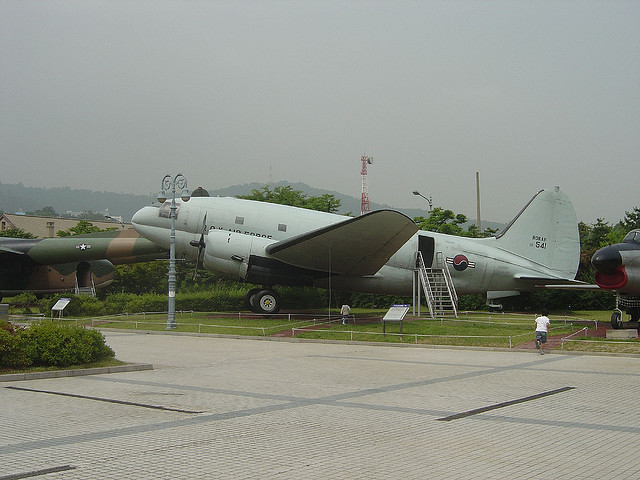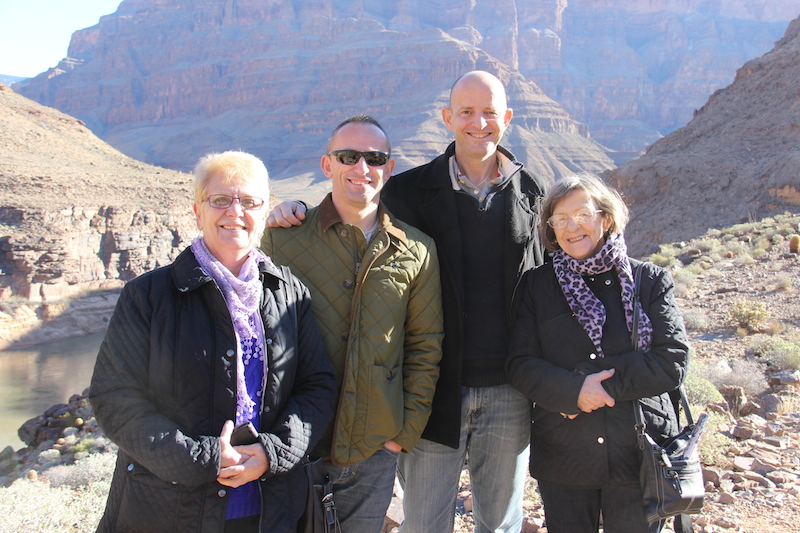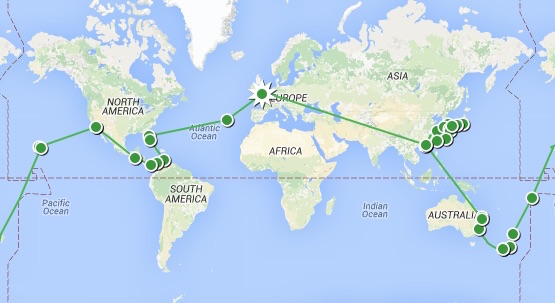Taipei, Taiwan. Observations and tips for visiting this city unused to heavy tourist trade
When I heard I was getting a chance to go to Taipei Taiwan, I was very excited as it was a place I was keen to visit.
As although you hear bits and pieces about Taiwan as it drifts in and out of the news every now and then, I realized that other than a broad understanding of the history and its very tense relationship with China, I knew very little about what it was like as a country – and what Taipei was going to be like as a capital city.
.JPG)
I read before I went that it was originally called Formosa, from the Portuguese word meaning “beautiful”. The Portuguese came across the 245 miles long and 89 miles wide island in the 16th Century, and were awed by the island’s steep mountains covered with very green and lush subtropical vegetation.
.JPG)
As I was on the flight there though that it first struck me that I had no actual reference for the image of what I imagined that it was going to be like. The only image I had seen was that of the Taipei 101 Building that I had seen many times in my pre-visit research on the internet. The image of this sleek and currently tallest building in the world had reinforced my mental image of what I expected to be a city chock full of very tall buildings and to be a very modern city.
.JPG)
Taiwanese people are more interested in ideas and in making things happen now and today, while the forces behind other rapid and fast growing cities like Shanghai are more driven by a “grand plan” and in the showcase and prestige that modern glitzy buildings offer, bulldozing down the old to make way for the new. In Taipei they seem to fill the old with the new.
It also seemed to make sense to me as I thought about and read more about the history of the island. It has a very strategic location just off 200 kilometers off the coast of China lying South of Japan and north of the Philippines. And, it seems to have basically been occupied or controlled in some form or fashion all of its life by an array of people that including the Portuguese, Japanese, the Dutch and the China Ming Dynasty.
Its more recent history being driven by events just after the 2nd World War in 1949, when there was civil war in China and the non-communist side called the KMT (Kuomintang) led by Chiang Kai-Shek, was losing to the Communists and so they fled from Mainland China and established themselves in Taiwan. A staggering 1.3 million people, mostly soldiers, KMT party members and wealthy people from Mainland China, fled and swamped the island. A military dictatorship was established under KMT as the Republic of China. In fact during the Cold War, most Western Countries recognized Taiwan as the “official” and legitimate government of China. This all changed as the major Western Powers started to court China.
All its recent life the country must have felt under threat, which it has been, and so it seems that as establishing themselves and protecting themselves had higher priority than grand designs and flashy buildings. Functionality was the key. This is what Taipei looks and feels like to me. But underneath all that is a very innovative and creative population.
Taipei does have, of course, a big new showcase that is Taipei 101, as I mentioned currently the tallest building in the world and one that I was really taken with and think it was almost visiting the city for.
It is built in a newly created part of town, which colleagues of mine from Taiwan say, used to be an old military area or compound of some sort. It is this area that a massive, and I mean massive, conference and exhibition center was built, modern shopping arcades, hotel and the quite stunning Taipei 101. I will talk more about the building later in the Tips when visiting. Other than here, there are not that many striking buildings (even old ones) in Taipei although there are a few very striking memorial halls and the museum but they are exceptions. Everything else is very functional.
.JPG)
One thing I soon did find out is that it seems that Taiwan and Taipei is not really on the “tourist” circuit, and it is not really geared very much for tourists, and has a surprisingly under developed tourist scene and structures.
Again it took me a while for this to sink in as I am so used to visiting other cities in Asia like Bangkok, Singapore, Hong Kong, Shanghai and the like which are very much “on the tourist circuit” and everyone from the hotels, taxi drivers, tour operators and even in stores are used to and ready for tourists.
Taipei is less so, not that people are unwelcoming at all – it is just that not many people come for a holiday there. And certainly not Western Tourists, although there seems to be a more steady Japanese tourist trade which links back to a time that run from the 1870s to just after the Second World War when Japan controlled Taiwan.
.JPG)
As an aside, having been educated in a more European based history and the First and Second Wars related to the European battlefields, I have only come to realize the last few years as I have been traveling through more of Asia just how far Japanese influence and territory extended prior to the 2nd World War.
.JPG)
Further clues to the fact that Taiwan was not really on the tourist circuit were there before I had arrived when I had been researching visiting online. I did not really find any good sources of tourist information.
I had also been looking for tours as often when going to a new place I like to, and recommend to others, to go on one of those bus tours where a taped or real guide takes you all round the major attractions and sights in a few hours and helps you grasp the layout of the city and decide where you want to invest the time you have best. I did not really find anything.
At the time I found that strange and so posted on a very helpful site called travbuddy.com where travelers post reviews and such and you can ask for help. I asked and eventually got only one reply from someone from Taiwan saying, there is not a lot to do as a tourist, listing 4 places (National Palace Museum, Taipei 101, Lung-Shan temple and Shi-Ling Night Market), and saying I would love the city and they were pleased I was coming!
.JPG)
Here are my tips for travellers visiting:
- It is not as easy to get to Taiwan on a direct flight as many of the more popular tourist countries in Asia, although EVA Air the main carrier based out of Taipei do seem to be expanding quite fast and offering more direct routes. There are no direct flights to and from China as China does not recognized Taiwan and will not allow flights to land directly from the island. As a result of all of the Hong Kong seems to be a major hub city for getting to Taipei. Cathy Pacific, the Hong Kong based airline, for example has flights that seem to be going almost every hour and they are always very busy. They also have a huge route network that fly into Hong Kong (I think about from 150 or so cities around the world) and that seems to be the next best alternative if Eva does not fly direct from the city you are traveling from. They also have, in my view, better seats and service
- I flew on Cathy Pacific from London, and on this trip was lucky enough to end up flying First both ways to Hong Kong and Business on the connecting flight. Read my review of Cathy Pacific by clicking hereThe airport is quite a long way out of town, although there is an airport in town but this is only for domestic flights. The international airport is called Chiang Kai-shek International airport and it is very modern. The traffic getting to and from the airport is slow, although the roads are very good but you need to allow well over an hour or more. I was very amazed with how lush and green and tightly packed the hills and mountains were with trees and vegetation. I don’t think I have ever seen such lush and tightly compacted trees. This showed to me how tropical the weather is.
- So, with a population of close to 23 million and large parts of the island being mountains and lush, the cities are busy. The one thing that Taipei did have in common with other major cities is pretty bad traffic, which also probably accounts for the hoards of scooters on the streets. There loads of them and the streets are designed to be very scooter friendly with special stopping space at the front of the queues at traffic lights.
- The city also seems to have loads and loads of taxis which are easy to find and very inexpensive. This may be a hang over from the pre subway transit system which is still quite new to the city, and called Metro Taipei which I am told is very good and modern, though I did not use it. I used taxis as they were so easy to find and so cheap. It is quite common to find that the taxi drivers do not speak or read English, and so make sure you get a local or the hotel to write down the name in Mandarin of where you want to go and have a card with the hotel address also in local language.
.JPG)
6. Visit the Chiang Kai-shek Memorial Hall
7. A very much must see is the National Palace Museum
The National Palace Museum boasts the world’s largest and most impressive collection of Chinese art and artifacts, dating back more than 7,000 years. The full collection comprises over 650,000 items, including calligraphy, paintings, jade, bronze, silk and curio pieces. Its seems there is so much than only a small percentage of the collection (maybe less than 10%) is displayed at any time. Most of the collection was taken from the Forbidden City in Beijing in 1949 by the KMT when they fled from China.
There is just so much to see, that you have to decide if you want to really explore it and spend a lot of time here or just get a flavour
8. Visit the Presidential Office Building
This renaissance-style building has been the highest seat of government in Taiwan for over a century, first as the office of the governor general’s office during the Japanese colonial period, and after 1949 as Taiwan’s “White House.” National festivals are hosted here and as I was there during the “moon Festival” which is a big deal I did not get to see anything more than the outside of it and all the seating and barriers being set up for the celebrations, It was an impressive looking building standing right in the middle of one of the main roads I guess to make it really stand out!
9. Go to a night market
· I am not a big fan of night markets but always end up going when in Asia as everyone raves about them and so I feel I need to go or I will miss out. The one to go to and the biggest and most popular is the Shilin Night Market. This sells everything, with of course lots of food.
· I also went to another night market within walking distance of Taipei 101 called the Tunghwa Night market which is probably as it was not really my idea of fun. It was mostly a food market and is very popular with people who like eating in open markets I guess. I found it very crammed as it is pretty much all crammed into one narrow street and hard to get through. Although I did find some colleauges who used to live in Taiwan and now ere working in other countries had made a bee line for that market to catch up on eating good old fashion Taiwan market food as soon as they landed and had checked in to the hotel – so I guess I was the one with the wrong approach and view!



